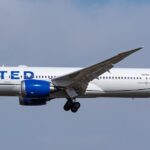Contrary to popular assumption, United Airlines provides more than just first, business, premium economy, and economy classes. Each of those cabins is separated into several fare classes, each with a different letter.
Read Also: How to Use United Airlines Low Fare Calendar
What is the fare class on United?
All United cabins of service are separated into fare classes, sometimes known as fare buckets, to keep track of the number of tickets sold on each flight and which seats are still available.
For example, if you’ve ever gotten a terrific deal on airfare only to see the price rise before you could purchase it, it’s most likely because the first fare class sold out, even if seats are still available in that cabin.
Despite their commonalities, airlines have significantly varied names for their fare classes. The following are United’s fare classes for each class of service on a purchased ticket:
First/Business Class
- Full fare: J.
- C and D are considered high fares.
- Discounted fare: Z.
- Deeply discounted fare: P.
Premium Plus
- High fare: O.
- Discounted fare: A.
- Deeply discounted fare: R.
Economy
- Highest full fare: Y.
- Full fare: B.
- High fare: M, E, H, and U.
- Discounted fares: Q, V, and W.
- Discounted fare: L, K, S, T.
- The lowest discounted fare: G.
- Basic Economy: N (for domestic flights).
How can I find my United Fare class?
The tariff classes are listed under each ticket category when looking for a ticket on United.
For example, in the image below, the most expensive flight from Chicago to Frankfurt, Germany has three fare classes: S in economy, R in premium economy, and P in business class. The lowest flight offers the following fare types: S in economy, A in premium economy, and D in business class.
Why should I pay attention to United’s fare classes?
There are several important reasons to consider the fare class you are booking. For starters, your fare class (particularly, the price) can influence how soon you reach elite rank and whether you qualify for an upgrade.
Elite status qualification
Passengers obtain elite status by combining Premier Qualifying Flights (PQF) and Premier Qualification Points (PQP). PQFs are based on completed flight segments. So, a nonstop flight counts as one PQF, whereas a one-stop flight counts as two PQF. Basic economy tickets are an exception, as they do not earn any PQF.
PQP includes the base fare, carrier-imposed taxes, seat purchases, and paid upgrades. So, the more costly your flight, the more PQP you earn and the faster you’ll reach elite rank.
Upgrade eligibility
To be qualified for an upgrade, you should have booked in the tariff class corresponding to the sort of upgrade you are seeking.
Complimentary Premier upgrades
If you’re a MileagePlus Premier member, tickets bought in specific fare classes qualify for quick gratis Premier upgrades (available on select itineraries). For instance, all Premier members’ economy tickets purchased in fare classes Y or B, as well as Premier members’ tickets purchased in tariff classes Y, B, or M 1K members, are eligible for automatic upgrades to the premium cabin during booking.
The following routes qualify for complimentary Premier upgrades:
- Continental United States (excluding premium transcontinental services).
- Hawaii from Los Angeles or San Francisco.
- Alaska, Canada, Mexico, the Caribbean, and Central America.
- Guam and Micronesia.
Aside from quick upgrades, you can boost your chances of receiving a gratis Premier upgrade by booking a higher fare class than another Premier member at the same status level.
Read Also: Round trip flights to Los Angeles

